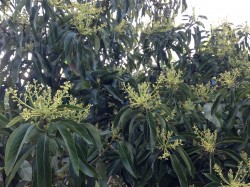Winter Blues
Community Contributed
By Glenn I. Teves, County Extension Agent, UH CTAHR
Because Hawaii is located on the northern edge of the tropics, winters are much colder here than in tropical areas, and is considered sub-tropical. What does that mean for tropical plants? The word “tropical” evoke visions of hot, steamy jungles, but there are also dry, high elevation areas.
The climate in which each plant species originated from usually determines how they will respond to cold winters. Avocado originated in three different climates in and near Central America, including West Indies, Guatemala and Mexico. Mexican avocado do well in the cooler California climate, while the Guatemala and West Indies varieties do better in Hawaii.
Mango originated in two different tropical areas, in drier India and wetter Southeast Asia. Mangos can be distinguished by their seed type, with Southeast Asia varieties having more than one embryo in each seed, while Indian mango has one embryo. When these species are crossed, the progeny can take on a character somewhere between its two parents.
Both avocado and mango benefit some from cold weather in slowing growth and encouraging flowering. Too much rain can damage flowers, create disease and affect the quality of the end product. Of the flowers produced by both avocado and mango, less than one percent of the flowers will form mature fruit.
Papaya and banana evolved in the truly tropical areas, banana near New Guinea, and papaya in Central America, and cold weather will dramatically slow the growth of both. Banana will suffer from black leaf streak or Sigatoka disease, which causes premature leaf drop. Banana flowers initiated during summer months will mature to ripe fruit in about 90 days, but when flowering in winter, will take anywhere from 120 to 150 days to mature.
Taro is another truly tropical plant that will slow down in winter, and is very susceptible to diseases affecting its leaves during cold and wet episodes, including leaf blight. Sweet potato and eggplant are also very tropical and do not enjoy cold winters as well, adversely affecting growth and days to maturity. The metabolic rate of these tropical plants will slow down in response to cold weather, but will have short spurts of growth on warm days between the cold, rainy ones.
So how can we help these plants weather the winter? “The time to fix a roof is before the rain.” Cold overcast weather with declining day lengths will stop truly tropical plants cold and dramatically slow growth. Fertilizing them when they’re actively growing before the end of summer is the key. Certain fertilizers, such as Phosphorus, will not move well up the roots when soil is cold, and must be incorporated into the soil when plants are rapidly growing. In this way, they will have good structural growth before the shorter days arrive. When bad weather arrives, plants will be ready and can endure the winter blues until better days are here in early spring.












Don't have a Molokai Dispatch ID?
Sign up is easy. Sign up now
You must login to post a comment.
Lost Password